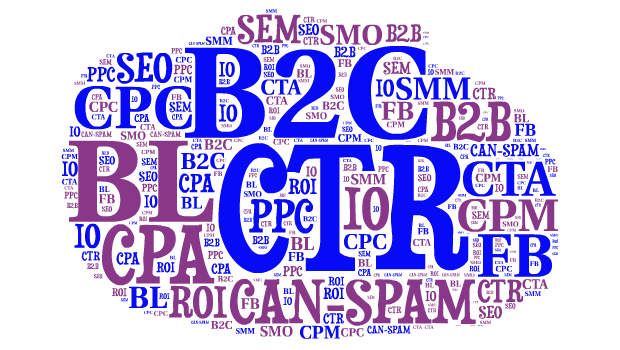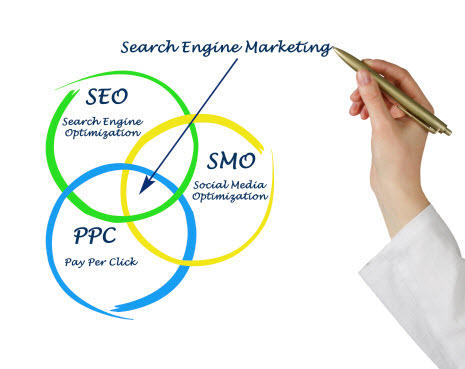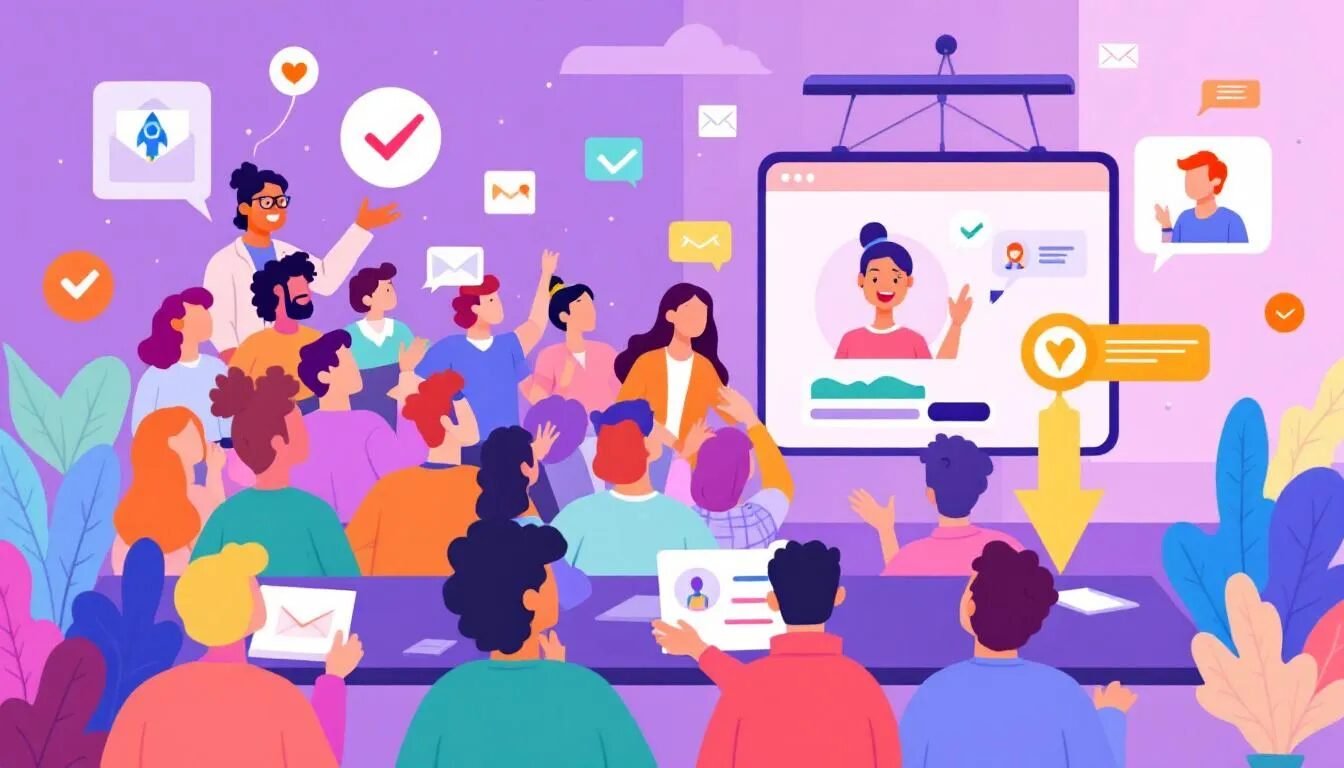
A Small Biz Guide to Digital Marketing Acronyms
There are semi easy-to-understand acronyms you might use in everyday life like, LOL (laugh out loud), ASAP (as soon as possible), TBD (too be determined) and even BYOB (bring your own beverage). And then there are acronyms associated with digital marketing that you may be less familiar with, especially since new ones crop up all the time. If you’ve ever heard or read an acronym and secretly wondered what it meant, you’re not alone: “I think you should update your CTA so your CTR increases, which will positively impact SEM, specifically PPC, which will give you a better ROI, plus help out your SEO as you market to both B2B and B2C markets.” Say what? To help you better understand the world of online marketing speak, here’s a list (and definitions) of commonly used digital marketing acronyms:
AIDA: Attention, Interest, Desire, Action is a the list of events a one should attempt to do, particularly when it comes to writing copy, in order to obtain customers with a website, online ad, email, blog post etc. Ex: Grab their attention, hold their interest, invoke desire (by talking about benefits, or solving a problem), and generate a call to action to influence your readers to do what you want them to do.
API: Application Program Interface is a set of rules, protocols or tools for building software applications.
B2B: Business to Business refers to companies that typically sell to other businesses (rather than to consumers).
B2C: Business to Consumer refers to companies that typically sell to consumers (rather than to other businesses).
BL: Backlink is a link from another website to your business’ website. Google uses backlinks in their algorithm to determine how search engine results are returned. Also known as inbound link.
CAN-SPAM: Controlling the Assault of Non-Solicited Pornography and Marketing Act of 2003 is a law that was passed in the U.S. to cut down on unsolicited emails. The act includes a list of requirements for businesses or individuals when sending out email. Rules like users must have the ability to opt out of receiving future communications, inclusion of a postal address of the sender, and no misleading subject lines.
CMS: Content Management System is a software or program used to organize, edit and publish content.
CPA: Cost Per Action is a type of online advertising where the advertiser is charged based on a specific action. Advertisers will pay for an action like a purchase, form submission or registration.
CPC: Cost Per Click is a type of online advertising where the advertiser is charged based on the number of times a visitor clicks on a link.
CPM: Cost Per Thousand is a type of advertising where the advertiser is charged based on the a thousand impressions or showings of an ad. Why isn’t it CPT then? It uses “M” for Mille, which is the roman numeral for one thousand.
CR: Conversion Rate is the number of visitors to a website or recipients of an email who take action beyond viewership
CRM: Customer Relationship Management is a business strategy or model for managing interaction and communication with leads or current customers.
CSS: Cascading Style Sheets is a “style sheet language” used to describe or define HTML/website or interface design elements (color, font, text alignment, borders, spacing).
CTA: Call to Action is a word or phrase that’s used to tell people what to do on the website or within an email. Some examples include “Learn More”, “Buy Now”, or “Sign Up.”
CTR: Click Through Rate is a measurement of how many people clicked on a particular link. You can measure CTR on your website based on number of visitors as compared to the number of visitors who click on a link on your homepage. Can also be used with email marketing to measure people who clicked on a link within your email.
CX: Customer Experience is the sum of all experiences a customer has with your product, website, etc.
ESP: Email Service Provider is a program or software that allows you to send emails and obtain tracking. VerticalResponse is an ESP.
GA: Google Analytics is a website and analytics reporting service created by Google that gives you various statistics in regards to website traffic.
FB: Facebook — This is kind of self-explanatory. Use “FB” to refer to all things Facebook.
HTML: Hyper Text Markup Language is the “language” or text makeup used to create webpages and any other information that could be viewed on the web.
IO: Insertion Order is a written contract between the advertiser and the ad agency or media rep. Typically used for print or broadcast ads. It usually includes specific instructions as to when the ad will begin, end, number of times to be shown, and it’s exact placement plus how much it costs.
KPI: Key Performance Indicator is a type of performance measurement or way to measure progress towards a specific goal.
PPC: Pay Per Click— An advertiser pays based on the number of times an ad is clicked on. If you advertise on a site like Google, you’ll pay based on the number of times a visitor clicks on your ad. This also is known as CPC or Cost Per Click.
PR: PageRank and/or Public Relations — PageRank from Larry Page of Google
PV: Page Views are the number of times a user visits a webpage.
ROI: Return on Investment refers to how successful a specific marketing campaign is. It’s the amount of profit you’ll get based on the revenue generated less the money you spent on an advertising activity. For example, it costs $5,000 a year to maintain your website (domain, hosting, copywriting, design fees, etc.), but is generates $20,000/year in revenue. Based on this example your ROI would be 400% ($20,000 divided by $5000).
RT: Retweet is a re-post or forwarded message on Twitter by another user.
SEM: Search Engine Marketing is the way businesses can promote their website within search engines (because everyone wants to show up on the top of page one). There are two components SEM: 1) typically, this refers to PPC advertising that would appear on sites like Google, Yahoo! or Bing. It’s the ads that appear on the top and side of those pages; and 2) include search engine optimization (SEO) to have their business show up naturally or organically within the results page.
SEO: Search Engine Optimization is the practice of optimizing a business’ website to achieve higher organic search results. Website owners can improve their SEO by including good content or keywords on their site, getting backlinks or links from other websites, and by structuring and naming their site appropriately so it makes it easier for search engines to find them. We’ve got a helpful Beginner’s Guide to SEO here.
SERP: Search Engine Results Page is the page users see the results of a web search they conducted (“pizza in San Francisco”). Search engines like Google, Yahoo! or Bing may have different layouts to their pages, but they all have SERPs. They typically include the paid or PPC ads plus organic search results.
SoLoMo: Social, Local, Mobile refers to a localized and mobile-centric version of search engine results.
SM: Social Media is the interaction and connection with various people on online platforms.
SMB: Small Business
SMM: Social Media Marketing is the tactic of using social media to market your business. See SMO.
SMO: Social Media Optimization is the process of using social media platforms to generate more interest in your business or drive more traffic to your website. There’s a wide variety of social media platforms like Facebook, Twitter, LinkedIn, YouTube, Pinterest, Google+ or writing your own blog.
UGC: User-Generated Content is a wide range of various media (blog posts, videos, photos etc.) created by the users (as opposed to the owners or employees) of a particular site or social media platform.
URL: Uniform Resource Locator is the web address or specific address of information found on the Internet.
UV: Unique Visitor is a distinct, individual visitor to a website who is only counted once, regardless how many times or web pages they visit.
UX: User Experience is the sum of experiences a customer has with your website, blog, etc.
Have any other marketing terms that should be added to the list? Add ’em below.
Want more marketing tips and tactics? Sign up for the free VR Buzz.
© 2014, Kathy McGovern. All rights reserved.




